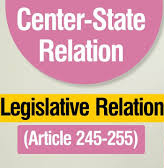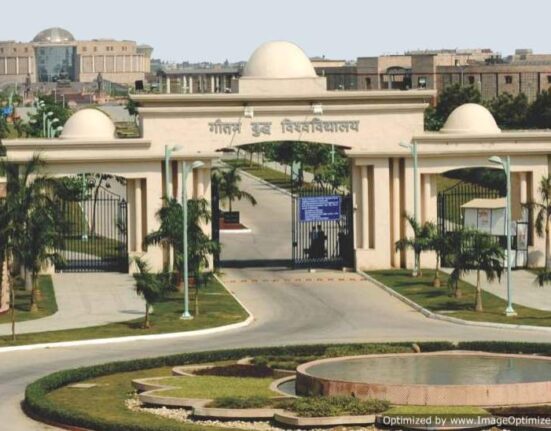Akshara Rajesh, a 2nd-year student, at CMR School of Legal Studies has written this article on “LEGISLATIVE RELATIONS BETWEEN UNION AND THE STATE“
Introduction
Article 1 of the Indian constitution states that ‘India is a union of states.’[1] India is a federal country, more specifically a federation of states. Our founding fathers believed that a strong centre and friendly relationship between the centre and the state must supplement the Indian governmental structure due to the prevailing political and social conditions at that time.
Dr B.R. Ambedkar said in the Constituent Assembly: “The Indian Constitution is a federal Constitution in as much as it established what may be called a dual polity which will consist of the Union at the Centre and the States at the periphery each endowed with sovereign powers to be exercised in the field assigned to them respectively by the Constitution”.[2]
In a federal government, there is a division of function between the Union and the State. The constitution has elaborately described the relationship between the union and states. We can understand this under the:
- Legislative relations
- Administrative relations
- Financial relations.
LEGISLATIVE RELATIONS: Between Union & State
There is a separation of power between unions and the states. Though this separation is not watertight, the constitution of India has clearly defined the jurisdiction of the centre and state. This division is two-fold in nature in terms of Legislative Relations Between Union & State :
- Territorial jurisdiction
- Subject-matter jurisdiction.
TERRITORIAL JURISDICTION OF STATE:
Article 245 of the Indian Constitution states that ‘Parliament may make laws for the whole or any part of the territory of India, and the Legislature of a State may make laws for the whole or any part of the State.’[3]
The Constitution clearly defines the territorial jurisdiction of both the centre and the state. Accordingly, the Parliament has the power to make laws for the whole or any part of the territory in India. This doesn’t mean that Parliament does not have extra-territorial jurisdiction.
Article 245(2) clarifies that no law enacted by Parliament shall be considered invalid on the basis of having extra-territorial operation.’[4] However, the State government has no such power or extra-territorial jurisdiction. They are restricted to make laws within the territory of the state. However, there is an exception to this general rule by means of ‘The Doctrine of Territorial nexus.’
DOCTRINE OF TERRITORIAL NEXUS:
This doctrine is applicable to scrutinize whether states have extra-territorial jurisdiction. To comprehend the meaning of this doctrine, let us analyse each component:
- Territorial – which means land or high seas that belong to a country
- Nexus – refers to the subject matter
Thus, this doctrine essentially identifies whether the object or the subject matter of the act has sufficient connection with the territorial boundary of the state. To provide further clarity, if there exists a territorial connection between the subject matter of the act and the state that enacts it, the concerned statute is not considered to have an extra-territorial application.[5]
CASE LAWS:
Wallace v. Income-tax Commissioner, AIR 1948 P.C. 118. [6]:
A company was established and registered in England. One of the partners started an office in India. The profit that the business accrued was majorly from India. Thus, the honourable court held that the tax levied on this company was within the territorial jurisdiction, since there was sufficient nexus between the subject matter and India.
State of Bombay v. RMD Chamarbaugwala, AIR 1958 SC 699[7] :
Bombay had a tax on lottery and prizes. The tax was levied on a newspaper printed and published in Bangalore but had wide circulation in Bombay. Thus, the court applied the doctrine of territorial nexus and pronounced that the State can impose a tax as there is sufficient nexus.
SUBJECT–MATTER JURISDICTION:
The Indian constitution has a very elaborate scheme of distribution of powers and functions between the Centre and the States.[8] Our founding fathers analysed various factors affecting the governmental structure in India, examined the political philosophies and also keeping in mind the future technological developments, devised an efficient scope of jurisdiction for the centre and state. The seventh schedule of the Indian constitution provides for the three lists that enumerate the division of functions between the centre and the state. They include:
Union List:
This list contains subjects over which only the Union Government has the power to legislate. Some of the important subjects in this list are defence, foreign affairs, currency, banking, communication, and interstate trade and commerce. It consists of 99 entries.
State List:
This list contains subjects over which only the State Governments have the power to legislate. Some of the important subjects in this list are law and order, health, agriculture, irrigation, local government, and state-level taxes. It consists of 61 entries.
Concurrent List:
This list contains subjects over which both the Union and the State Governments have the power to legislate. Some of the important subjects in this list are education, forests, criminal law, marriage, divorce, and adoption. It consists of 47 entries.
Thus, the Indian constitution clearly lays down the jurisdictional boundary between the centre and the state. This is done in order to ensure a balance of power and efficient legislative relations.
Relevancy of Article 246 of the Indian Constitution:
Article 246 of the Indian Constitution, further states the subject matter of laws made by Parliament and by the Legislatures of States.
The article provides that —- “Subject-matter of laws made by Parliament and by the Legislatures of States. —
(1) Notwithstanding anything in clauses (2) and (3), Parliament has exclusive power to make laws with respect to any of the matters enumerated in List I in the Seventh Schedule (in this Constitution referred to as the “Union List”).
(2) Notwithstanding anything in clause (3), Parliament, and, subject to clause (1), the Legislature of any State also, have the power to make laws with respect to any of the matters enumerated in List III in the Seventh Schedule (in this Constitution referred to as the “Concurrent List”).
(3) Subject to clauses (1) and (2), the Legislature of any State has exclusive power to make laws for such State or any part thereof with respect to any of the matters enumerated in List II in the Seventh Schedule (in this Constitution referred to as the “State List”).
(4) Parliament has the power to make laws with respect to any matter for any part of the territory of India not included 2 [in a State] notwithstanding that such matter is a matter enumerated in the State List.”[9]
Therefore, we can conclude that the Union List and the Parliament are dominant based on our analysis. In case of any conflict between the central law and the state law, the central law will prevail. Thus, we can observe that India has a centralized federation and that the Parliament is given greater primacy.
PRINCIPLES OF INTERPRETATION OF THE LISTS:
‘Federalism implies a legalistic form of government.’
As there is a separation of powers between the federal government and the states, no government may exercise its authority outside of its designated sphere without violating the constitution. There is often a dispute over the jurisdiction of a particular issue between governments. The courts must make such decisions as it is their responsibility to ensure that no government surpasses its authority.
Therefore, in order to verify the validity of the law or determine whether any jurisdiction has been violated, the court applies various doctrines
- The Doctrine of Pith and Substance
- The Doctrine of Harmonious Construction of Lists
- The Doctrine of Colorable Legislation
- Doctrine of Repugnancy
DOCTRINE OF PITH AND SUBSTANCE:
In their own individual spheres or jurisdictions, both the centre and the state are complete sovereigns. However, if a law enacted by one transgresses or encroaches upon the jurisdiction of the others, the court will decide on the validity of the law. Accordingly, the court applied the doctrine of pith and substance and attempted to identify whether the legislature was competent to enact the law. To adjudge whether any particular enactment is within the purview of one legislature or the other, it is the pith and substance of the legislation in question that has to be looked into.[10] This rule envisions that if the ‘true nature and intent’ or the ‘object’ of the law was within the jurisdiction of the legislature, then the court can hold that there has been no transgression of jurisdiction.
In the case of Prafulla Kumar v. Bank of Commerce, Khulna, [74 I.A. 23.];
The Bengal Moneylender Act of 1940’, which set a ceiling beyond which moneylenders could not collect any money, was passed for the benefit of the general populace. Even the interest rate was limited to what the money lenders could charge. Due to the Act’s low loan rate, lenders questioned its legality. The act was questioned on the basis that it only applied to promissory notes, which was a subject matter of the union list and hence, the state legislature has encroached upon the powers of the parliament. However, the court held that the true intent of the legislature was to deal with money lending and was within the sphere of state list.
DOCTRINE OF HARMONIOUS CONSTRUCTION:
The Doctrine of Harmonious construction aims at the interpretation of the provisions of the law in such a way that it can harmoniously coexist with another. To elucidate further, if there are two laws conflicting with each other, the court tries to interpret the provisions such that both the laws can coexist and attempts to effect a reconciliation between them.
In the case of, Venkataramana v. State of Mysore, AIR 1958 SC 255,
The principle has been also been applied to resolve the conflict between Arts. 25(2)(b) and 26(b),2 and to delimit the mutual relationship between the Directive Principles and Fundamental Rights.[11]
In the case of O. N. Mohindroo vs The Bar Council Of Delhi & Ors [1968 AIR 888][12],
There came a conflict concerning the suspension of advocates under the Advocates Act of 1961. According to List 1, entry 77 dealt with persons entitled to practise before Supreme Court and High Court and List 2, entry 26 dealt with Legal, medical and other provisions. To resolve the conflict, the Supreme Court applied the rule of harmonious construction and held that parliament can exclusively legislate in matters related to persons entitled to practise before the Supreme court and High court. All other matters about the rest of the practitioners fall under list 3.
POWER OF PARLIAMENT TO LEGISLATE ON STATE SUBJECTS:
Article 249 to article 256 of the Indian constitution deals with those areas where the parliament has the power to legislate over the state subjects. They can be briefly explained under the following headings:
- IN THE MATTERS OF NATIONAL INTEREST [ARTICLE 249].
- Under proclamation of National emergency [ARTICLE 250]
- BY AGREEMENT BETWEEN THE STATES [ARTICLE 252]
- IMPLEMENTATION OF A TREATY [ARTICLE 253]
- EMERGENCY (Constitutional Breakdown of Machinery of State) [ARTICLE 356]
- EXPANSIVE NATURE OF SOME UNION ENTRIES
CONCLUSION: Legislative Relations Between Union & State
Constitutional provisions regulate the legislative relations between the state and the union. The constitutional makers have to an extent tried to maintain the federal character and at the same time attempted to give dominance to the Union Government. Such a model of federalism is unique to India and suits the social, political and economic conditions of the country. These provisions enable India to uphold its democratic nature. The true intent of federalism is to uphold the rights of the people, ensure democracy runs in its soul and also, provide a strong institutional framework. Louise Tillin argues that we must view the interactions between federalism and democracy as dynamic rather than static. Thus, this article enumerates the legislative relations between the union and states.
[1] Ind. Const. (Art 1).
[2] Aniruddha Babar is an Asst. Professor of Law and PhD Scholar at Seedling School of Law and Governance at Jaipur National University
[4] Ind. Const. (Art 245(2)).
[5] MP JAIN, INDIAN CONSTITUTIONAL LAW 533 (8th ed. 2018).
[6] Wallace v. Income-tax Commissioner, AIR 1948 P.C. 118.
[7] State of Bombay v. RMD Chamarbaugwala, AIR 1958 SC 699.
[8] MP JAIN, INDIAN CONSTITUTIONAL LAW 533 (8th ed. 2018). Legislative Relations Between Union & State
[9] Ind. Const. (Art. 246)
[10] MP JAIN, INDIAN CONSTITUTIONAL LAW 533 (8th ed. 2018).
[11] Venkataramana v. State of Mysore, AIR 1958 SC 255.
[12] O. N. Mohindroo vs The Bar Council Of Delhi & Ors [1968 AIR 888].
![]()







Leave feedback about this